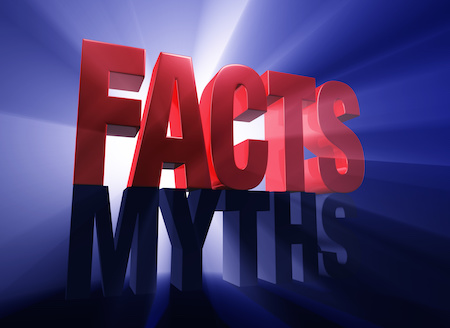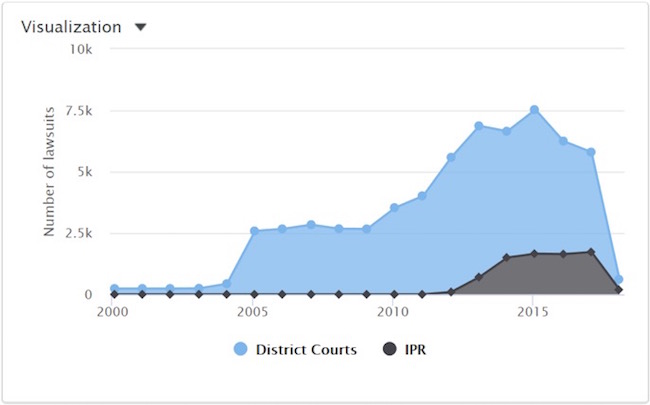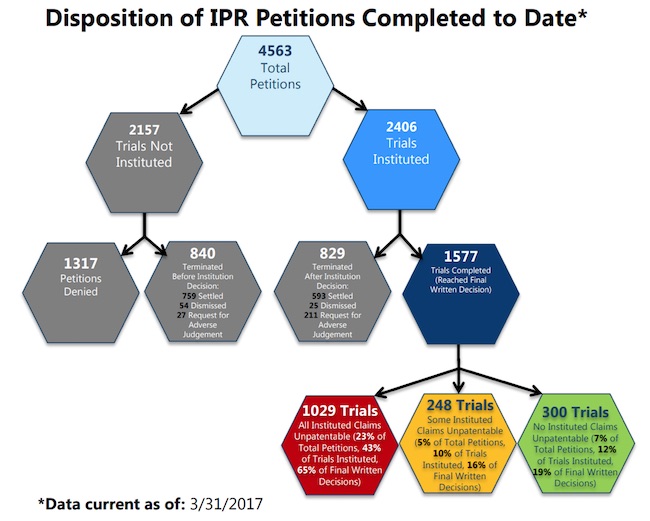 IPR advocates have touted the success and impact of the Inter Partes Review (IPR). Some studies proclaim IPRs have saved billions in overall legal costs since their adoption. The problem is their reliance is on the 80% litigation-stay rate for instituted IPRs. When a court stays a litigation and an IPR results in a settlement, adverse judgement invalidating all claims, or a final decision invalidating all claims, then the IPR reduces overall costs, which are the total litigation and IPR costs for both plaintiffs and defendants to resolve the dispute. But if the PTAB denies the IPR petition or allows one or more challenged claims, then the IPR fails to resolve the disputes between the parties, and any imposed stay may be lifted. In these instances, IPRs increase overall costs.
IPR advocates have touted the success and impact of the Inter Partes Review (IPR). Some studies proclaim IPRs have saved billions in overall legal costs since their adoption. The problem is their reliance is on the 80% litigation-stay rate for instituted IPRs. When a court stays a litigation and an IPR results in a settlement, adverse judgement invalidating all claims, or a final decision invalidating all claims, then the IPR reduces overall costs, which are the total litigation and IPR costs for both plaintiffs and defendants to resolve the dispute. But if the PTAB denies the IPR petition or allows one or more challenged claims, then the IPR fails to resolve the disputes between the parties, and any imposed stay may be lifted. In these instances, IPRs increase overall costs.
A closer look reveals that IPRs have a nominal impact to reduce overall costs—just 6%. The average NPE patent litigation costs $950K and, according to my estimates, lasts between 1 and 2 years. This average cost does not account for IPR costs, to determine overall costs. It does, however, account for the existence of IPRs. How have IPRs impacted average litigation costs? Has it decreased them by helping resolve validity issues less expensively? Has it increased them when patents survive IPRs?
I have yet to come across data that shows how IPRs impact litigation costs, because it would require isolating IPR impact from that of the AIA’s joinder laws, 101 Alice case law, venue law from T.C. Heartland, and other legislation and case law. We can, however, conduct a delta analysis to determine how IPRs affect overall costs, when we take the 950K-average litigation cost as a baseline.
In 2017 there were 4072 patent litigation filings. Applying the average NPE litigation cost, total litigation costs for 2017 would be $3.86B. How do IPRs impact litigation costs, and thereby overall costs to resolve legal disputes between parties?
Methodology
Some litigations have one asserted patent, while others have multiple patents. If an IPR invalidates all claims, it results in multiple litigation settlements in single patent cases, but potentially none with multiple asserted patents.
To account for this, in 2015 there was an approximate 1.5 litigation-to-1 unique patent ratio (6364 patent filings on 4048 unique patents). Applying this ratio to 2017 patent filings, this corresponds to 2714 unique patents for 2017.
In 2017 there were 1725 IPR filings. 70% of IPRs filed relate to patents in litigation. Of the IPRs associated with patents in litigation, approximately 80% map to unique patents. This means 966 patents in 2017 have an IPR associated with them.
On average, defendants spend $200,000 before an IPR is filed. The median cost for filing an IPR petition is $100K, and for reaching a final decision is $250K by each party ($500K total). (Citing to AIPLA 2017)
To run the delta-cost analysis, let’s assume an IPR settlement results in a settlement of the associated litigation, an adverse judgement or invalidity of all claims results in a settlement of the associated litigation and other litigations pertaining to the invalidated patent, and that an IPR denial or allowance of one or more of the challenged claims does not resolve the litigation issues and, thus, does not result in a settlement. Of course, individual litigation circumstances may vary, but they provide a baseline to perform a delta-cost analysis, to determine how IPRs impact overall costs.
Application
According to USPTO statistical data, of those 966 IPRs, 30% will result in a settlement, either before or after institution. Assuming an IPR settlement results in a litigation settlement between the parties, this results in 289 litigation settlements. The overall cost to reach the settlement would be $300K ($200K in litigation costs prior to IPR filing + $100K for petition filing). This creates a savings of $650,000 from the average cost of litigation, resulting in +$187.8M of overall-cost savings.
Of the 966, 5% will result in an adverse judgement, thereby invalidating the challenged claims. This will result in 48 litigation settlements between the respective parties. It would cost $300K to reach this result ($200K in litigation costs prior to IPR filing + $100K for petition filing), saving 650K from the average cost of litigation. Because the claims are invalidated, 24 other litigations will be resolved (applying the 1.5:1 litigation to unique patent ratio). For these 24, taking the average cost of $200K in litigation costs prior to IPR filing, there will be a savings of $750K from the average cost of litigation. The overall-cost savings are +$49.2M for adverse judgements.
Of those 966, 23% will result in all claims being unpatentable after final decision. Assuming invalidating all claims results in a settlement, there will be 222 litigation settlements. Applying the 80% litigation-stay rate, 177 cases will be stayed. The average cost for the stayed litigations are $700K ($200K in litigation costs before IPR petition filing + $500K borne by plaintiffs and defendants to reach final IPR decision), resulting in $250K of savings from the average cost of litigation. For the 20% (44) in which there is no stay, litigation continues for at least 18 months (timing from IPR filing to final decision), which falls within the 1-to-2 year average for litigation. Assuming average litigation costs apply to the non-stayed cases, these IPRs increases overall costs by $500K per litigation (cost by each party to reach final IPR decision). This results in an overall-cost savings of +$22.2M.
Because all claims are invalidated, 111 other litigations will be resolved (applying the 1.5:1 litigation to unique patent ratio). Applying the 80% stay rate, 88 litigations will have an average cost of $200K (litigation costs before IPR petition filing), resulting in a savings of $750K from the average cost of litigation. Similar to above, the non-stayed litigations will not have cost savings. This results in an additional overall-cost savings of +$66M.
Of the 966,
29% will result in a denial of institution, meaning the IPR fails to resolve the issues between the parties. For 280 litigations the IPR increases overall costs of the parties by $100K (cost to file IPR petition). This increases overall costs by -$28M.
1% will result in a dismissal. For 9 litigations, the IPR increases overall costs by $100K (cost to file IPR petition), which increases overall costs by -0.9M.
12% result in one or more claims being allowable. For these 115 cases, the IPR increases overall costs by $500K (cost by each party to reach final IPR decision), because the IPR fails to resolve the legal issues. Litigation continues, regardless of whether or not a stay was imposed. This increases overall costs by -$57.5M.
Taking the above scenarios into consideration, IPRs in 2017 result in an overall-cost savings of +$238.8M.
If the total litigation cost is $3.86B and IPRs save $238.8M in overall costs, IPRs serve to reduce yearly overall costs by just 6%. When discussing the impact of IPRs, we must consider instances when IPRs increase overall costs. Doing so highlights their nominal impact to overall costs when resolving legal disputes.

![[IPWatchdog Logo]](https://ipwatchdog.com/wp-content/themes/IPWatchdog%20-%202023/assets/images/temp/logo-small@2x.png)



![[Advertisement]](https://ipwatchdog.com/wp-content/uploads/2024/04/Patent-Litigation-Masters-2024-sidebar-early-bird-ends-Apr-21-last-chance-700x500-1.jpg)

![[Advertisement]](https://ipwatchdog.com/wp-content/uploads/2021/12/WEBINAR-336-x-280-px.png)
![[Advertisement]](https://ipwatchdog.com/wp-content/uploads/2021/12/2021-Patent-Practice-on-Demand-recorded-Feb-2021-336-x-280.jpg)
![[Advertisement]](https://ipwatchdog.com/wp-content/uploads/2021/12/Ad-4-The-Invent-Patent-System™.png)







Join the Discussion
2 comments so far.
Benny
March 11, 2018 01:47 am“This creates a savings of $650,000 from the average cost of litigation”
That is not a sum our company would sneeze at. For one medium sized company, that is a significant slice of the budget, worthy of serious consideration and not brushed off as “just 6%”.
Josh Malone
March 9, 2018 02:37 amExcellent analysis. I can vouch for the data here, both from my own harrowing experience and related research I have done.
The estimated 6% savings is achieved by cheating inventors of their property rights, denying them due process, clouding the titles of the 3 million patents in force, and overruling the Article III courts.